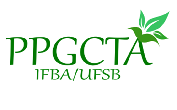Banca de QUALIFICAÇÃO: WINNIE AGUIAR VIRGENS
Uma banca de QUALIFICAÇÃO de MESTRADO foi cadastrada pelo programa.DISCENTE : WINNIE AGUIAR VIRGENS
DATA : 30/11/2020
HORA: 15:00
LOCAL: modo virtual
TÍTULO:
Floristics, Phytogeography and Conservation in the Atlantic Forest: an experience in the cabrucas of the Pau-Brasil Settlement, Extreme South of Bahia
PALAVRAS-CHAVES:
cocoa; plant diversity; Phytogeography; Submontane Ombrophilous Forest; Bahian Hileia.
PÁGINAS: 85
GRANDE ÁREA: Outra
ÁREA: Ciências Ambientais
RESUMO:
The band Ombrophilous Forests belonging to the south of Bahia and the north of Espírito Santo is one of the main centers of endemism in the Atlantic Forest and has a vast richness of species. The cabruca system ensured much of the conservation of the region's biodiversity and wealth, while other places in the biome suffered more intensely from fragmentation. The Pau-Brasil Settlement, Itamaraju-BA, is an area with cabruca cocoa implanted around 91 years ago and has a vast forest remnant. This research aimed to carry out the floristic characterization of the fragments with cocoa plantations in the area, to conduct a phytogeographic analysis by comparing the location with the floristics of other places in the Atlantic Forest and to draw up a list of native species marketable for generating income for local residents. 32 collection expeditions were carried out, with approximately 1,800 samples of vascular plants belonging to 90 families, 222 genera and 369 species, recorded in four phytophysiognomies: 1) cabruca forests; 2) ciliary forests; 3) vegetation in slabs; and 4) disturbed areas. Four new species were found, belonging to the families Araceae, Connaraceae and Salicaceae, 63 spp. endemic to the Atlantic Forest biome and 15 spp. threatened with extinction. The peculiarity of the area indicates a low level of similarity with the others, being more compatible with the Environmental Preservation Areas and the FLORAS Botanical Garden, mainly due to the anthropic influence in these places and the sharing of species in the managed areas. The scientific and ethnobotanical bibliographic survey initially presented a ranking of 30 native species with the greatest potential for use, distributed in 19 families, the most representative being Fabaceae (20%), and the arboreal habit (73%) the most expressive.
MEMBROS DA BANCA:
Presidente - 1782304 - JAILSON SANTOS DE NOVAIS
Interno - 034.751.739-05 - CAROLINA WEBER KFFURI - UFSB
Externo ao Programa - 1802621 - CRISTIANA BARROS NASCIMENTO COSTA



